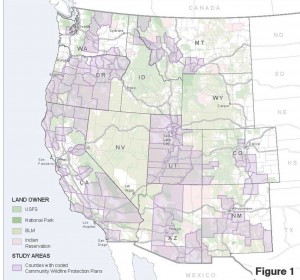CWPPs in the West by the Ecosystem Workforce Program
JESSE ABRAMS, AUTUMN ELLISON, MELANIE KNAPP, CASSANDRA MOSELEY, TRAVIS PAVEGLIO, AND MAX NIELSEN-PINCUS
Large wildfires are increasingly common in the American West. The federal government is responsible for the majority of suppression costs, and has a significant interest in policies that can improve resilience at the community level. The Healthy Forests Restoration Act (HFRA) of 2003 encourages communities to complete Community Wildfire Protection Plans (CWPPs). While not mandatory, CWPPs give communities access to federal and state funding for activities highlighted in plans. HFRA allows flexibility to adapt plans to local contexts; however, little is known about whether communities have capitalized on the opportunity to develop site-specific plans that meet the needs of individual communities. This research analyzed CWPP structure and content to better understand variability between plans.
 Approach
Approach
We examined 113 CWPPs crafted in response to the Healthy Forests Restoration Act. Analyzed plans represented communities in 10 western states affected by large wildfires between 2004 and 2011 (see figure 1).
Results
The majority of plans (89%) were completed at the county or sub-county level. There was great diversity among CWPPs, which ranged from 9 to 339 pages in length and listed between 3 and 26 stakeholder interests as being involved in plan creation. 82% of plans explicitly defined the wildland-urban interface (WUI); two-thirds of these provided definitions specific to their communities rather than relying on the HFRA definition of WUI.
Risk reduction strategies. Fuel treatment strategies were more common than any other type of strategy for reducing risk. 86% of plans identified priority areas for fuel reduction treatments, as required by HFRA. Three treatment actions were present in over 80% of CWPPs: creation of defensible spacearound residences and other structures; creation of fuel breaks; and forest stand thinning. These actions reflect HFRA’s focus on altering fuel loads near communities to reduce wildfire risk. In contrast, only one-quarter of CWPPs included plans for residential fire-resistant landscaping, less than 5% discussed homeowner certification standards for fire mitigation, and less than a quarter encouraged community volunteer development. This distribution of strategies across plans suggests that although HFRA allows great latitude to adapt plans to local contexts, CWPPs tend to share a common emphasis on a relatively small range of activities centered on fuel reduction.
Institutional strategies. Education and outreach efforts were the most common institutional strategy identified in CWPPs, with 89% of plans offering guidance on altering homeowner behavior through outreach and education to encourage voluntary actions. Nearly all CWPPs focused on professionalized fire response rather than on building homeowner or volunteer capacity.
Implementation strategies. Relatively few plans contained implementation strategies for recommended actions. While 35% of plans identified an implementation committee, less than a third identified the resources, schedule, or costs necessary for implementation, and only 20% of plans identified a lead coordinator to oversee implementation.
Consultant involvement. Slightly less than half of CWPPs noted a consultant forester, GIS specialist, consulting organization, or academic professional as a preparer. Consultant-led plans included a greater number of strategies than non-consultant led plans, were more than 50% longer, and were more likely to include explicit wildland-urban interface definitions. Consultant-led plans were also more likely to include implementation resources, schedules, and costs than non-consultant-led plans. Overall, consultant-led plans were slightly more comprehensive in terms of risk reduction, institutional, and implementation strategies. Previous research has shown the importance of community engagement in CWPP creation. Consultant involvment has the potential to strengthen or undermine the overall value of plans depending on the modes of consultant and community involvement.
Implications. Communities can engage in the CWPP creation process in many different ways. Our research suggests that while many communities have taken advantage of the opportunity to develop a CWPP, they have not fully capitalized on the flexibility to develop unique site-specific plans. Despite high variability in plan length, WUI definitions, and specific implementation mechanisms, most CWPPs represented a fairly standardized model focused on risk reduction through vegetation management and professionalized response. They gave little attention to actions by homeowners and communities to build less ignitable structures or to build local community capacity for fire preparedness and response. Plans were also generally lacking in elements necessary to implement the strategies they proposed. As CWPPs are revised and updated, there is ample room for diversification, improvement, and community engagement.
More Information
For more information about the project and additional publications go to: www.ewp.uoregon.edu/wfresilience.
This research was supported by funding from the USDA National Institute for Food and Agriculture, Grant #2011- 67023-30695. Header photo by Emily Jane Davis. The University of Oregon is an equal-opportunity, affirmative-action institution committed to cultural diversity and compliance with the Americans with Disabilities Act. This publication will be made available in accessible formats upon request. © 2014 University of Oregon. Design and Editing Services DES0410-044i-H52729


Great to see this project reach the end of the rainbow! Great work ISE folks, I’m glad I had a chance to contribute to some pioneering research 🙂
We miss your laughter and incredible energy at the CSC. Hope to see you soon. 🙂